A Performance That Was Hard to Miss
On Display Global took over a heavily-trafficked corridor in Seegers Union to spark a discussion about disabilities, both visible and invisible.By: Meghan Kita Friday, December 15, 2017 08:00 AM
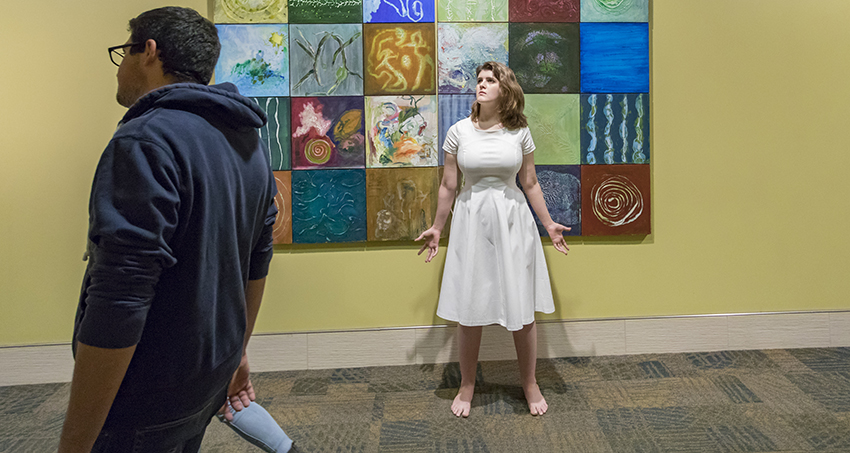 One of the On Display Global performers poses in a Seegers Union hallway as other students pass. Photos by Paul Pearson.
One of the On Display Global performers poses in a Seegers Union hallway as other students pass. Photos by Paul Pearson.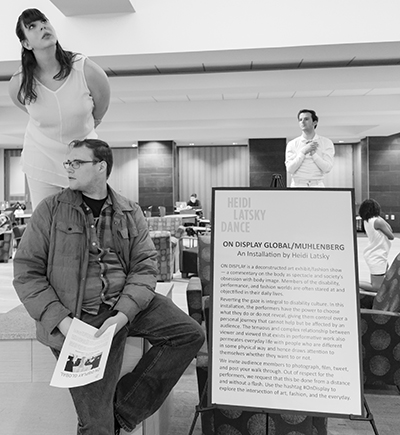 Students surround every table in the Seegers Union Light Lounge. It’s a Friday afternoon in December, and the few students who are trying to work are wearing headphones to drown out their peers’ chatter. It’s the end of the week and the end of the semester, and a mixture of excitement and anxiety courses through the space. And excitement and anxiety are loud.
Students surround every table in the Seegers Union Light Lounge. It’s a Friday afternoon in December, and the few students who are trying to work are wearing headphones to drown out their peers’ chatter. It’s the end of the week and the end of the semester, and a mixture of excitement and anxiety courses through the space. And excitement and anxiety are loud.
At 4:30 p.m., eighteen people dressed entirely in white exit the Seegers Union Great Room and take their places along the hallway between Java Joe and the Wood Dining Commons. A few white-clad students enter the Light Lounge itself. Two of them stand on a couple of the aforementioned already-spoken-for tables. The performers each strike statuesque poses, with their eyes open and their gazes soft. And within seconds, the Light Lounge falls silent.
The performers are taking part in On Display Global, a work that originated with New York City-based Heidi Latsky Dance. Each year, performances happen in New York City and worldwide on or around the International Day of Persons with Disabilities (December 3). During each iteration of On Display Global, performers take over a public space for an hour to encourage passersby to look—maybe even to stare—and, in doing so, to acknowledge the variety of bodies that are present.
Leticia Robles-Moreno, visiting assistant professor of theatre and dance, helped bring On Display Global to Muhlenberg. “This performance is beautiful in its simplicity. It’s basically putting bodies in the space, moving very quietly, very calmly, just being there,” Robles-Moreno says. “The idea is for passersby to say, ‘I should engage and try to understand instead of looking away, being afraid, ignoring and erasing these bodies.’”
On Display Global’s Path to Muhlenberg
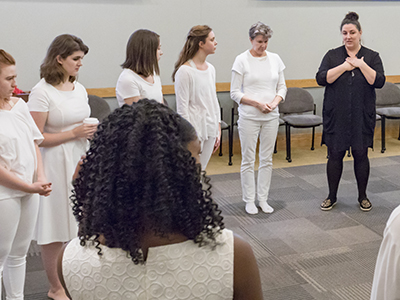 Robles-Moreno’s former colleague Maria Schirmer (left, in black) joined Heidi Latsky Dance in the summer of 2014, as the company prepared for the premiere of On Display at Lincoln Center that fall. Latsky is known for including dancers of all capabilities in her works, some of which (like On Display) are meant to be about disability and some of which are not. “It’s all work that allows unique and different bodies on stage,” Schirmer says.
Robles-Moreno’s former colleague Maria Schirmer (left, in black) joined Heidi Latsky Dance in the summer of 2014, as the company prepared for the premiere of On Display at Lincoln Center that fall. Latsky is known for including dancers of all capabilities in her works, some of which (like On Display) are meant to be about disability and some of which are not. “It’s all work that allows unique and different bodies on stage,” Schirmer says.
On Display Global—which brought satellite On Display performances to locations outside New York City—began last year, and this year, Latsky encouraged her collaborators to reach out to their networks to spread the project further. Schirmer knew Robles-Moreno had recently started teaching at Muhlenberg, which seemed an ideal venue for expansion.
“It’s not only bringing awareness about people with disabilities to Muhlenberg, but also bringing Muhlenberg into this global conversation,” Robles-Moreno says. “It’s an act of inclusion that we’re trying to perform.”
Schirmer made the journey from New York City to Allentown to host a workshop for participants before the performance.
“There was something really lovely about having a full afternoon together and having people be able to practice the work before the performance,” Schirmer says. “It’s a very vulnerable project, and it can be hard for folks to jump into that, whether they’re performers or not.”
Preparing to Be on Display
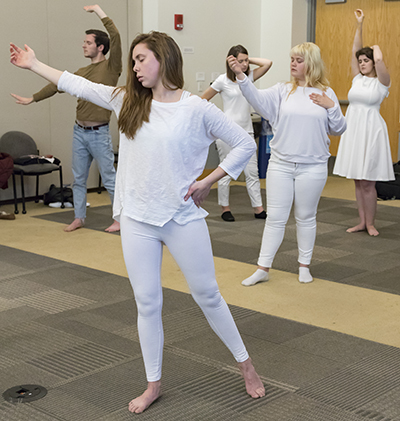 The workshop, which takes place in the Seegers Union Great Room before the performance, begins with introductions and videos from previous On Display productions. The group discusses the definition of “disability.” Because the group of 16 students and two women from the Allentown community who will participate today are able-bodied, the discussion turns to other types of differences in ability.
The workshop, which takes place in the Seegers Union Great Room before the performance, begins with introductions and videos from previous On Display productions. The group discusses the definition of “disability.” Because the group of 16 students and two women from the Allentown community who will participate today are able-bodied, the discussion turns to other types of differences in ability.
“Difference sometimes is marked by skin tone, shape, size or what your body is able to do, but sometimes it’s internal,” Robles-Moreno says. “There are visible and invisible disabilities. In a college setting, internal struggles are frequent, and we need to talk about it because it’s another way to embrace difference.”
Then, Schirmer shows the group what they’ll be doing. She asks Robles-Moreno to strike a sculptural pose, to hold it, and then, when she can’t hold the pose anymore, to close her eyes and “morph.”
“It’s very internal and core-oriented,” Schirmer says. “It’s slow.”
She instructs Robles-Moreno to freeze when she finds the her next pose, then to open her eyes. Her gaze should be soft, her jaw relaxed. The group gives it a try before heading out into the hallway, where Schirmer decides where each performer should be placed. She staggers them, starting near the information desk and finishing outside the entrance to the Wood Dining Commons, with a few performers stationed in the Light Lounge along the way. Two female student-performers, whom Schirmer placed on the ramp outside the Light Lounge, laugh nervously. “Honestly, I thought we were going to be in the Event Space,” one says to the other.
“It’s very different to perform on the stage than to take over a public space,” Robles-Moreno says later. “It’s an act of bravery. You need to learn to be vulnerable, and how to transform that vulnerability into strength.”
After everyone knows their places, the group returns to the Great Room for a lengthy, meditative warmup, with a focus on deep breathing and body awareness. Then, they do a 12-minute “trial run” of the performance.
Schirmer observes, then gives some advice: If you’re going to try sitting or lying on the ground, “you can’t get there quickly—it can take the audience out of it if you get there too fast.” Keep the focus of the poses on your body: “Don’t allow your clothing or your hair to be a prop.” And resist the urge to smooth or pull down errant clothing: “It just adds another level of vulnerability to this performance.”
With that, she instructs the group to change into their “whites”—the “costume” of On Display Global, meant to help performers stand out to passersby—and to prepare to take over the space.
Reflections on the Performance
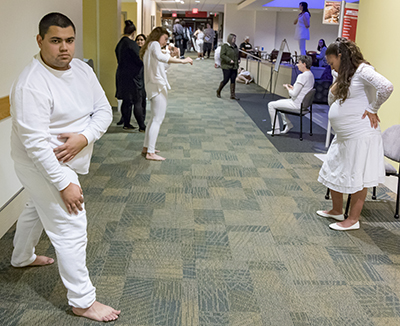 After the hour-long performance, the group returned to the Great Room to debrief.
After the hour-long performance, the group returned to the Great Room to debrief.
“In the wrap-up we discussed how the performers heard some people talking about them and how empowering it is to be in the position of saying, ‘I am the one allowing you to look at me and to talk about me,’” Robles-Moreno says.
One of the student performers was Dan Dobro ’18 (left), a theatre and English major and a Dana Scholar who’s writing about On Display Global as part of his mentorship with Robles-Moreno.
“It was weird because, even though I’m a performer and I’m used to being looked at, I’m not usually looked at as myself,” Dan says. “The whole idea of the piece is to draw the audience’s attention to the bodies themselves, and I found that my own attention was being brought to my body in a very real way. It was almost meditative, but I was also hyper-aware of every muscle and bone and tendon.”
Kate Ekanem ’21 heard about On Display Global in the first-year seminar she took, Representing the Body in Art with associate professor of education Pearl Rosenberg, and she came to Seegers to check it out. “I waited longer because I just couldn’t leave,” Kate says. “I enjoyed looking at each expression and gesture.”
Both Robles-Moreno and Schirmer hope to host On Display Global at Muhlenberg again next year, and to incorporate more members of the Allentown community into the performance on campus, to add a second performance in a more public space in the city or both.
“It is necessary for the community to understand that art and politics, or political art, can be everywhere,” Robles-Moreno says. “They don’t need to go to a gallery to see art; they don’t need to go to the theater.” And to participate, “you don’t need to be a performer—you just need to have a body.”
She hopes that the seniors who participated in On Display Global will become ambassadors for Heidi Latsky Dance and On Display Global wherever they end up after graduation. Dan, who’s from Brooklyn, plans to return to the city after he graduates—unless he quickly achieves his career goal of being cast in a traveling production.
“I joked with Leticia this morning that if I end up on tour somewhere, then I can see about putting something together,” Dan says.
The goal, according to Robles-Moreno, is to continue spreading the message that it matters whom you choose to see (and whom you choose to overlook). “If you’re going to look at something, look at it so you understand and engage. If you’re looking away, do it because you’re being considerate and not because you’re judging and erasing,” Robles-Moreno says. “There is power in who you decide to look at and who you decide to not look at. If performance and art can change that, we should start exploring that.”
See a video from the On Display Global performance at Muhlenberg from Marco Calderon on Vimeo.
